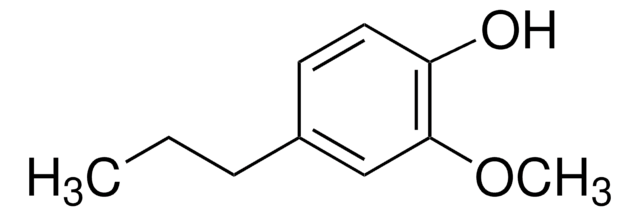W243604
4-Ethylguaiacol
≥98%, FCC, FG
Synonim(y):
4-Ethyl-2-methoxyphenol, NSC 82313
About This Item
Polecane produkty
pochodzenie biologiczne
synthetic
Poziom jakości
klasa czystości
FG
Fragrance grade
Halal
Kosher
agency
follows IFRA guidelines
meets purity specifications of JECFA
zgodność regionalna
EU Regulation 1223/2009
EU Regulation 1334/2008 & 178/2002
FCC
FDA 21 CFR 117
FDA 21 CFR 172.515
Próba
≥98%
współczynnik refrakcji
n20/D 1.528 (lit.)
tw
234-236 °C (lit.)
mp
15 °C (lit.)
gęstość
1.063 g/mL at 25 °C (lit.)
Zastosowanie
flavors and fragrances
Dokumentacja
see Safety & Documentation for available documents
alergen pokarmowy
no known allergens
alergen zapachowy
no known allergens
Organoleptyczne
bacon; clove; leather; smoky; spicy
ciąg SMILES
CCc1ccc(O)c(OC)c1
InChI
1S/C9H12O2/c1-3-7-4-5-8(10)9(6-7)11-2/h4-6,10H,3H2,1-2H3
Klucz InChI
CHWNEIVBYREQRF-UHFFFAOYSA-N
Szukasz podobnych produktów? Odwiedź Przewodnik dotyczący porównywania produktów
Powiązane kategorie
Opis ogólny
Zastosowanie
- Co-culture fermentation by Saccharomycopsis fibuligera and lactic acid bacteria improves bioactivity and aroma profile of wheat bran and the bran-containing Chinese steamed bread.: This study examines the impact of co-culture fermentation on the bioactivity and aroma of wheat bran, with a focus on the contribution of 4-Ethylguaiacol to flavor enhancement in food processing, emphasizing its potential for improving the nutritional and sensory quality of baked goods (Tang et al., 2024).
Opakowanie
Hasło ostrzegawcze
Warning
Zwroty wskazujące rodzaj zagrożenia
Zwroty wskazujące środki ostrożności
Klasyfikacja zagrożeń
Eye Irrit. 2 - Skin Irrit. 2 - STOT SE 3
Organy docelowe
Respiratory system
Kod klasy składowania
10 - Combustible liquids
Klasa zagrożenia wodnego (WGK)
WGK 2
Temperatura zapłonu (°F)
226.4 °F - closed cup
Temperatura zapłonu (°C)
108 °C - closed cup
Środki ochrony indywidualnej
Eyeshields, Gloves, type ABEK (EN14387) respirator filter
Certyfikaty analizy (CoA)
Poszukaj Certyfikaty analizy (CoA), wpisując numer partii/serii produktów. Numery serii i partii można znaleźć na etykiecie produktu po słowach „seria” lub „partia”.
Masz już ten produkt?
Dokumenty związane z niedawno zakupionymi produktami zostały zamieszczone w Bibliotece dokumentów.
Klienci oglądali również te produkty
Nasz zespół naukowców ma doświadczenie we wszystkich obszarach badań, w tym w naukach przyrodniczych, materiałoznawstwie, syntezie chemicznej, chromatografii, analityce i wielu innych dziedzinach.
Skontaktuj się z zespołem ds. pomocy technicznej










